2012 Mini Cooper S John Cooper Works Hatchback. Click image to enlarge |
| Test Drive: 2010 Mini Cooper S JCW Cabrio
Manufacturer’s web site |
Review and photos by Mike Schlee
Photo Gallery:
2012 Mini Cooper S JCW
There are some vehicles out there with an appeal words cannot convey. There is some magical element that attracts people to these vehicles in a religious way. People who do not fall under this supernatural spell do not understand why others are so adamant that their vehicle is the best thing since sliced bread. Many Jeep owners wear this as a badge of honour and proudly display stickers on their vehicles claiming “It’s a Jeep thing. You wouldn’t understand”. Recently, I saw a Pontiac Aztek with a similar bumper sticker claiming it was an Aztek thing and I wouldn’t understand; you, sir, are correct, I don’t understand.
And that brings us to the Mini. The original BMC Mini, and its entire line of offspring, firmly resides in the land of fanatical cult followings. Every conceivable automotive body style has been grafted onto the minuscule Mini chassis since 1959 and Mini fans have loved every one of them; well, most of them at least. Fast-forward to the new millennium and a retro-look Mini is unleashed in 2001, sparking a whole new generation of Mini loyalists, albeit on a lesser level.
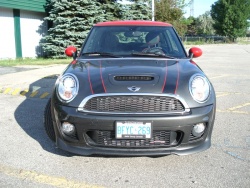 2012 Mini Cooper S John Cooper Works Hatchback. Click image to enlarge |
I am one who has never had a bad case of Mini fever. In fact, I have barely even had a Mini sniffle or Mini headache. Sure, I think they are cool cars and know about their handling prowess, but I have always written them off in my mind due to their front-wheel-drive layout and my perception that they are overpriced. So what is the best way to test whether my fact-less assumptions were correct? Why, by testing out the baddest, fastest, meanest Mini currently on the market: the Mini Cooper S John Cooper Works.
The John Cooper Works (JCW) package is available on any of Mini’s current models as long as they already have the turbocharged engine from the S models. The John Cooper Works adds some serious performance punch to the already peppy Cooper S. The 1.6L turbocharged four-cylinder engine is pumped up to 208 hp and 192 lb-ft of torque. Overboost is standard on all turbocharged Minis and allows the turbo to hit a higher peak PSI for short bursts, thus increasing torque to 207 lb-ft. To help get this power to the ground, the JCW features an electronic differential locking control (EDLC), which is basically a simulated limited-slip differential using the brakes to control wheel-spin under hard cornering conditions.
But how does a 1,210 kg vehicle handle this much power being fed through its front wheels? Surprisingly well, actually. I was certain it would turn into a torque-steer nightmare, but it never did. Power is immediate and with a little rpm dialed up, the Mini will launch from a dead stop with little drama. Unless high-rpm clutch-drops are performed, you would be hard pressed to know this car isn’t all-wheel drive as the tires grip and go. Yes, turbo lag at lower rpms is noticeable, but actually, it is quite good when you consider the engine is making 129 lb-ft of torque per litre of displacement. The waste gate is loud, as is the turbo when spooling, and I love it. I would find myself driving around in high gears, constantly playing with the accelerator pedal just to induce a ‘hiss’ and ‘psssh’ turbo symphony.
The JCW comes only with a six-speed manual, and thankfully, it is a great unit. Although the shift knob is strangely shaped and uncomfortable, and the throws are long, the gear changes themselves are fluid and engage smoothly. In the 1,750 km I spent behind the wheel of the JCW, I never missed a shift. The Mini does cruise at high rpms on the highway; 100 km/h arrives at 2,500 rpm in sixth gear while 120 km/h is at 3,000 rpm. The exhaust, which sounds sporty while ripping around town, becomes a bit of a droner on the highway. An upside to this high gearing, though, is the immediate power delivery in sixth gear at highway speeds. The car is more responsive at 100 km/h in sixth gear than in some V8 muscle cars travelling in high gear thanks to the high rpms at cruising speed and low turbo lag. In fact, the Mini has a deceptively faster-than-it-really-is feel as it seems much quicker than the officially rated 0–100 km/h time of 6.5 seconds.
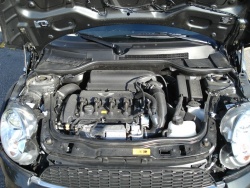 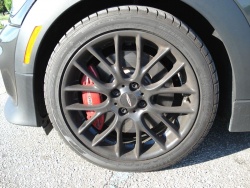 2012 Mini Cooper S John Cooper Works Hatchback. Click image to enlarge |
But power is merely one half of the performance upgrade the JCW brings to the Mini; handling is the other. The JCW package adds high performance 205/45R17 tires, upgraded brakes (316 mm up front, 280 mm in the rear), and an upgraded suspension. I had been warned by several people before driving the Cooper S JCW hatchback that the ride would be punishing. I was expecting medieval levels of torture from the horror stories I had heard, but honestly, it is not that bad. Sure it is a rough ride, but it is certainly no stiffer or jolting than a 2010–2012 Hyundai Genesis Coupe and is almost on par with the 2012 MX-5 GT in ride comfort; two vehicles I have spent extensive hours behind the wheel of. I drove the JCW clear across Detroit twice in my week with it and survived—without bruises.
The upside of this stiff suspension is handling prowess. The levels of grip are impressive, but the JCW’s pièce de résistance is the intuitive handling that makes it feel like an extension of your body. When put into the JCW’s sport mode, the over-used term “go-kart handling” really does apply. I found myself quickly taking highway on-ramps and off-ramps with more confidence than normal. The car just lets you know what it is doing at all times. Think of it as the FWD RX-8 when it comes to driver feedback. Oh, and the usual front-wheel-drive understeer push is all but missing in this car; it takes real dedication to achieve the levels of speed in a corner that upset this chassis.
As great of a performer as this car is, it is a Mini, so it must also look cool. The JCW package adds side air inlets that are chrome-plated, an 85-mm centre-mounted twin-outlet exhaust, custom black 17-inch wheels and a two-tone paint job complete with Mini-appropriate striping. I am usually not a fan of two-tone paint jobs, but the Mini’s dark grey paint job with red roof, red mirrors, and red outlined black stripes looks great. It is the sort of paint job only a Mini could get away with.
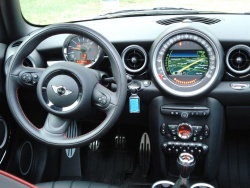 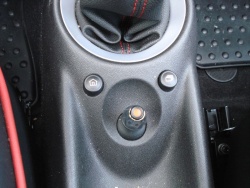 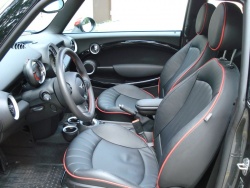 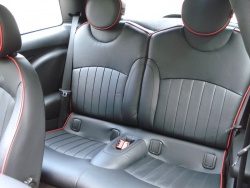 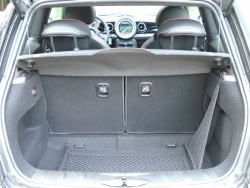 2012 Mini Cooper S John Cooper Works Hatchback. Click image to enlarge |
The JCW upgrades continue inside as the six-speed shift diagram on the shift knob is detailed in red, and piano black interior accents are found throughout. One of the first things I noticed when sitting in this Mini was the upgraded centre speedometer and infotainment gauge that is a piece of automotive art. The floating speedo needle surrounding the center screen looks futuristic and retro at the same time. Controlling this infotainment unit is a tiny joystick-like control knob between seats that is very easy to use and intuitive, although the downside is that nothing can be stored between the seats or else the knob is buried. Another note to make, the GPS system did lead Senior Editor Jonathan Yarkony and I astray twice in Detroit and we were left circling the city.
There is a double-paned sunroof that runs the length of the roof and unlike most double-pane roofs both sections can open. The rear section only vents upward and closes if the front sunroof pane is opened all the way, but this is still more functionality than found in most rear sunroof panes. When the front pane is opened, the gap in the roof is large and airy. A large wind buffeter pops up at the leading edge and takes away nearly all wind interference inside the Mini’s cabin. The downside is that this wind-screen sticks up so far that it becomes a bug collector—especially in the country or at night.
The front seats are comfortable and supportive, but not meant for long distance cruising. They are better for a long trip than the Mazda MX-5’s seats, but not by much. ‘New’ Mini interiors have always included an array of toggle switches that are love them or leave them; they are decidedly retro in look and feel. The rest of the JCW-trimmed interior featured soft touch materials everywhere but both steering wheel and shift knob seemed cheap and down market for a $40K car; why not drop in one of those fabulous BMW wheels for JCW models?
The Mini hatch provides a lot more space than its exterior dimensions led me to believe. I fit my tall torso with no problems in the front seats and thanks to the square dimensions of the Mini, could fit in the rear seats as well, albeit with a bit less legroom than I would like. In fact, four average-sized adults can fit in Mini as long as there is no cargo, or 2 adults can travel with a ton of luggage as long as the rear seats are folded down. For those into specs and numbers, there is only 160 L of cargo space behind the rear seats, but it grows into an impressive 680 L with the rear seats folded down.
So the Mini JCW definitely dispelled my doubts that a front-wheel-drive vehicle could perform this well. What about my other preconceived notion that it is overpriced? Well, as always, that becomes a matter of personal opinion. At $42,830, this is not a cheap Mini. On one hand, it is easy to argue that this is a $43,000 sub-compact hot hatch, which seems ridiculous when compared to the likes of the Veloster Turbo, 500 Abarth, or even a WRX. However, on the other hand, this is a solidly built, luxuriously appointed near-luxury sporty car that I would take in a heartbeat over BMW’s own, similarly priced, six-speed manual 328i I drove recently. Yes, that is quite a bold statement coming from this rear-wheel-drive-loving reviewer, but I found it just that rewarding. Oh, and the icing on the cake? The Mini JCW averaged 7.1 L/100 km after nearly 2,000 km of driving. I guess I finally get what these Mini-Fanatics have been preaching all along.
Pricing: 2012 Mini Cooper S John Cooper Works
Base price: $36,900
Options: Comfort Package ($1,900), Wired Package ($1,850), Championship Red Lounge Leather ($1,900), Black Light Alloy Wheels ($150), John Cooper Works Bonnet ($130)
A/C tax: $100
Freight: $1,595
Price as tested: $44,525
Specifications











